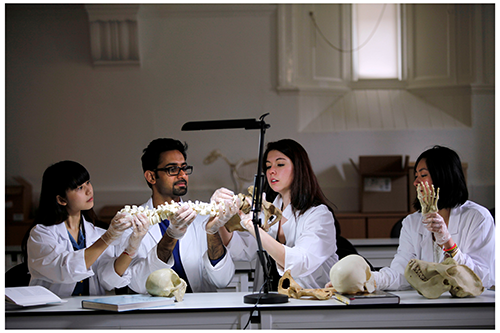Engaging the professional community in teaching medical students by Simon Riley
Student Selected Components in the undergraduate Medicine programme.

You might think that the teaching content in a professional vocational degree like medicine – defined by the governing body the General Medical Council (GMC) and detailing what a medical student should know as they exit their undergraduate programme and embark on their first day as a junior doctor – would be almost entirely prescriptive. And of course, you would be right. However, what the GMC also requires in medical curriculum design is that all Medical Schools offer students space in their timetables for some choice, enabling them to study some topics in more depth, beyond the core learning.
Choice is essential
Choice is essential, as students need to gain the professional and academic skills to allow them to go into much greater depth when they graduate. Inevitably, when students make these choices it is linked to career exploration. With the reduced flexibility and time in current postgraduate training programmes this is vital to help students make an appropriate and informed choice for traineeship.
The Edinburgh Medical School uses Student Selected Components (SSCs) as part of the medicine timetable to deliver a range of learning outcomes which mainly relate to developing research skills, and professional development including teamwork and teaching skills. These SSCs comprise 20% of the whole 5 year timetable, and it amounts to more choice than most other Medical Schools, and more than the roughly 10% prescribed by the GMC.
Offering choice presents a series of challenges and opportunities to the curriculum developer. For example, how do we work with the professional community to support the 850+ students that are undertaking the Bachelor of Medicine programme at any one time? Our approach has been to give autonomy and responsibility to the students early in the programme, and let them arrange their own attachments and placements with professional staff.
Alignment of aims between student and community is essential for success
For the SSCs to be a success, the tasks must be aligned with staff and student aims. The tasks are designed to be useful and, if possible, not too onerous. Students must arrange their own placements, which will likely be in a medical specialty they are considering as a possible career. For example in 4th year, by which time students have already acquired some useful research skills, they can plan and manage their own project.
This is often a local clinical audit or service evaluation under the supervision of a medical consultant, which can be then used to make improvements to local medical practice. And of course it will not be long before the student who is working on a project graduates and becomes a potential trainee, and senior staff are always looking to encourage and motivate trainees who will become consultants in their discipline in the future.
It is remarkable how the broader health care community embraces the opportunity to have some interaction with undergraduate medical students. For short periods, students shadow a member of the healthcare team, who is not a medical doctor. These can be obvious choices, including nurses, midwives, paramedics, pharmacists, radiographers, physiotherapists, or community health visitors.
Make the task undertaken valuable
But some students choose to shadow less obvious roles, including the hospital chaplain, orthopaedic plaster technician, morgue attendant, or lifeboatman. The student’s task is to analyse the professional’s team, and what makes it work effectively (or otherwise, sometimes). The professional is not involved in assessment of the student, although they are empowered to report any concerns.
These professionals are consistently positive in their feedback on the scheme, indicating they recognise the benefits of informing undergraduate medical students about the extended healthcare team to make them more aware of the value of their colleagues and the challenges they face. In a short time these students might themselves be fully integrated into the team, and quite soon after leading and taking decisions.
There is a traditional mantra in medical education of 'see one, do one, teach one'. This can be viewed as a basis for acquiring medical skills, or portrayed as a traditionalist’s simplistic cliché for learning surgical procedures. Nevertheless, the broad philosophy underlying the mantra remains strong. It emphasises the importance of experiential learning and the whole professional community being involved in teaching. The SSC programme gives medical students autonomy and some ownership of their own learning, and allows the wider community to nurture, encourage, engage, and work with these students.

